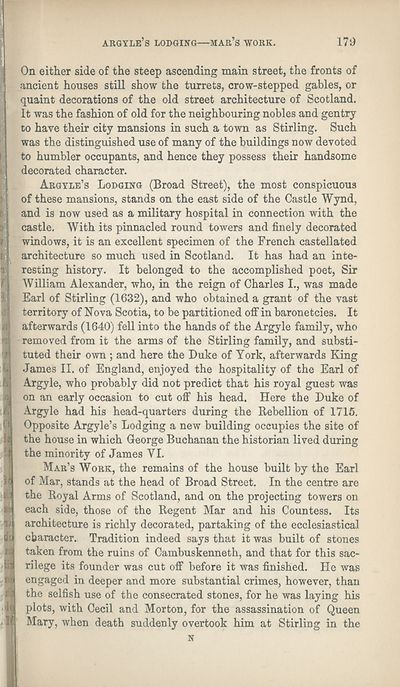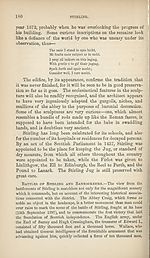Download files
Complete book:
Individual page:
Thumbnail gallery: Grid view | List view

argyle’s lodging—mar’s work.
179
On either side of the steep ascending main street, the fronts of
ancient houses still show the turrets, crow-stepped gables, or
quaint decorations of the old street architecture of Scotland.
It was the fashion of old for the neighbouring nobles and gentry
to have their city mansions in such a town as Stirling. Such
was the distinguished use of many of the buildings now devoted
to humbler occupants, and hence they possess their handsome
decorated character.
Argyle’s Lodging (Broad Street), the most conspicuous
of these mansions, stands on the east side of the Castle Wynd,
and is now used as a military hospital in connection with the
castle. With its pinnacled round towers and finely decorated
windows, it is an excellent specimen of the French castellated
architecture so much used in Scotland. It has had an inte¬
resting history. It belonged to the accomplished poet, Sir
William Alexander, who, in the reign of Charles L, was made
Earl of Stirling (1632), and who obtained a grant of the vast
territory of Nova Scotia, to be partitioned off in baronetcies. It
afterwards (1640) fell into the hands of the Argyle family, who
• removed from it the arms of the Stirling family, and substi¬
tuted their own ; and here the Duke of York, afterwards King
James II. of England, enjoyed the hospitality of the Earl of
Argyle, who probably did not predict that his royal guest was
on an early occasion to cut off his head. Here the Duke of
Argyle had his head-quarters during the Rebellion of 1715.
Opposite Argyle’s Lodging a new building occupies the site of
the house in which George Buchanan the historian lived during
the minority of James YI.
Mar’s Work, the remains of the house built by the Earl
of Mar, stands at the head of Broad Street. In the centre are
the Royal Arms of Scotland, and on the projecting towers on
each side, those of the Regent Mar and his Countess. Its
architecture is richly decorated, partaking of the ecclesiastical
character. Tradition indeed says that it was built of stones
taken from the ruins of Cambuskenneth, and that for this sac¬
rilege its founder was cut off before it was finished. He was
engaged in deeper and more substantial crimes, however, than
the selfish use of the consecrated stones, for he was laying his
plots, with Cecil and Morton, for the assassination of Queen
Mary, when death suddenly overtook him at Stirling in the
179
On either side of the steep ascending main street, the fronts of
ancient houses still show the turrets, crow-stepped gables, or
quaint decorations of the old street architecture of Scotland.
It was the fashion of old for the neighbouring nobles and gentry
to have their city mansions in such a town as Stirling. Such
was the distinguished use of many of the buildings now devoted
to humbler occupants, and hence they possess their handsome
decorated character.
Argyle’s Lodging (Broad Street), the most conspicuous
of these mansions, stands on the east side of the Castle Wynd,
and is now used as a military hospital in connection with the
castle. With its pinnacled round towers and finely decorated
windows, it is an excellent specimen of the French castellated
architecture so much used in Scotland. It has had an inte¬
resting history. It belonged to the accomplished poet, Sir
William Alexander, who, in the reign of Charles L, was made
Earl of Stirling (1632), and who obtained a grant of the vast
territory of Nova Scotia, to be partitioned off in baronetcies. It
afterwards (1640) fell into the hands of the Argyle family, who
• removed from it the arms of the Stirling family, and substi¬
tuted their own ; and here the Duke of York, afterwards King
James II. of England, enjoyed the hospitality of the Earl of
Argyle, who probably did not predict that his royal guest was
on an early occasion to cut off his head. Here the Duke of
Argyle had his head-quarters during the Rebellion of 1715.
Opposite Argyle’s Lodging a new building occupies the site of
the house in which George Buchanan the historian lived during
the minority of James YI.
Mar’s Work, the remains of the house built by the Earl
of Mar, stands at the head of Broad Street. In the centre are
the Royal Arms of Scotland, and on the projecting towers on
each side, those of the Regent Mar and his Countess. Its
architecture is richly decorated, partaking of the ecclesiastical
character. Tradition indeed says that it was built of stones
taken from the ruins of Cambuskenneth, and that for this sac¬
rilege its founder was cut off before it was finished. He was
engaged in deeper and more substantial crimes, however, than
the selfish use of the consecrated stones, for he was laying his
plots, with Cecil and Morton, for the assassination of Queen
Mary, when death suddenly overtook him at Stirling in the
Set display mode to:
![]() Universal Viewer |
Universal Viewer | ![]() Mirador |
Large image | Transcription
Mirador |
Large image | Transcription
| Antiquarian books of Scotland > Scotland/Scots > Black's picturesque tourist of Scotland > (259) |
|---|
| Permanent URL | https://digital.nls.uk/130031298 |
|---|
| Description | Thousands of printed books from the Antiquarian Books of Scotland collection which dates from 1641 to the 1980s. The collection consists of 14,800 books which were published in Scotland or have a Scottish connection, e.g. through the author, printer or owner. Subjects covered include sport, education, diseases, adventure, occupations, Jacobites, politics and religion. Among the 29 languages represented are English, Gaelic, Italian, French, Russian and Swedish. |
|---|

